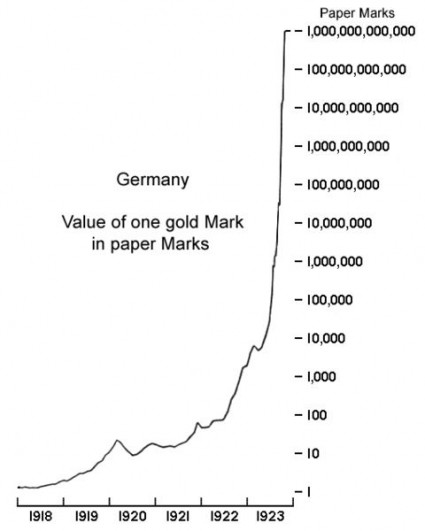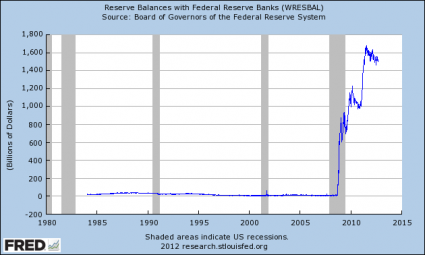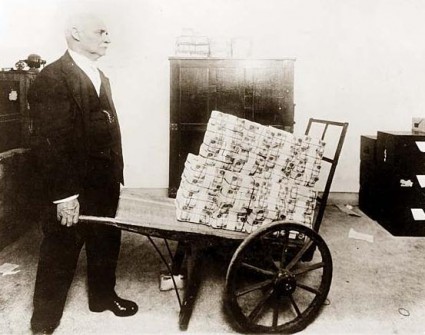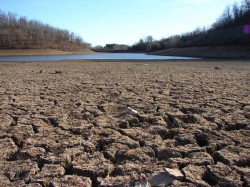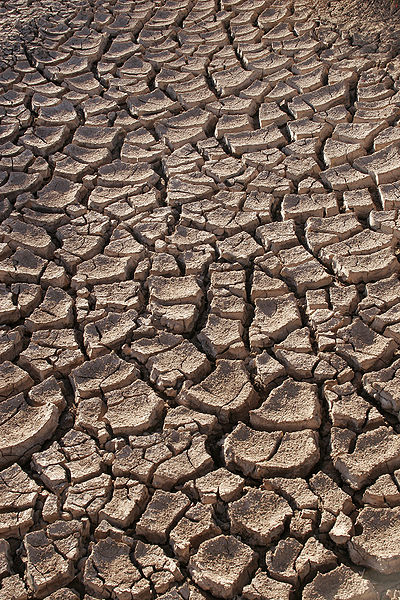 Did printing vast quantities of money work for the Weimar Republic? Nope. And it won’t work for us either. If printing money was the secret to economic success, we could just print up a trillion dollars for every American and be done with it. The truth is that making everyone in America a trillionaire would not mean that we would all suddenly be wealthy. There would be the same amount of “real wealth” in our economy as before. But what it would do is render our currency meaningless and totally destroy faith in our financial system. Sadly, we have not learned the lessons that history has tried to teach us. Back in April 1919, it took 12 German marks to get 1 U.S. dollar. By December 1923, it took approximately 4 trillion German marks to get 1 U.S. dollar. So was the Weimar Republic better off after all of the “quantitative easing” that they did or worse off? Of course they were worse off. They destroyed their currency and wrecked all confidence in their financial system. There was an old joke that if you left a wheelbarrow full of money sitting around in the Weimar Republic that thieves would take the wheelbarrow and they would leave the money behind. Will things eventually get that bad in the United States someday?
Did printing vast quantities of money work for the Weimar Republic? Nope. And it won’t work for us either. If printing money was the secret to economic success, we could just print up a trillion dollars for every American and be done with it. The truth is that making everyone in America a trillionaire would not mean that we would all suddenly be wealthy. There would be the same amount of “real wealth” in our economy as before. But what it would do is render our currency meaningless and totally destroy faith in our financial system. Sadly, we have not learned the lessons that history has tried to teach us. Back in April 1919, it took 12 German marks to get 1 U.S. dollar. By December 1923, it took approximately 4 trillion German marks to get 1 U.S. dollar. So was the Weimar Republic better off after all of the “quantitative easing” that they did or worse off? Of course they were worse off. They destroyed their currency and wrecked all confidence in their financial system. There was an old joke that if you left a wheelbarrow full of money sitting around in the Weimar Republic that thieves would take the wheelbarrow and they would leave the money behind. Will things eventually get that bad in the United States someday?
Of course we are not going to see hyperinflation in the U.S. this week or this month.
But don’t think that it will never happen.
The people of Germany never thought that it would happen to them, but it did.
The following is an excerpt from a Wikipedia article about the Weimar Republic. Take note of the similarities between what the Weimar Republic experienced and what we are going through today….
The cause of the immense acceleration of prices that occurred during the German hyperinflation of 1922–23 seemed unclear and unpredictable to those who lived through it, but in retrospect was relatively simple. The Treaty of Versailles imposed a huge debt on Germany that could be paid only in gold or foreign currency. With its gold depleted, the German government attempted to buy foreign currency with German currency, but this caused the German Mark to fall rapidly in value, which greatly increased the number of Marks needed to buy more foreign currency. This caused German prices of goods to rise rapidly which increase the cost of operating the German government which could not be financed by raising taxes. The resulting budget deficit increased rapidly and was financed by the central bank creating more money. When the German people realized that their money was rapidly losing value, they tried to spend it quickly. This increase in monetary velocity caused still more rapid increase in prices which created a vicious cycle. This placed the government and banks between two unacceptable alternatives: if they stopped the inflation this would cause immediate bankruptcies, unemployment, strikes, hunger, violence, collapse of civil order, insurrection, and revolution. If they continued the inflation they would default on their foreign debt. The attempts to avoid both unemployment and insolvency ultimately failed when Germany had both.
When the Weimar Republic first started rapidly printing money everything seemed fine at first. Economic activity was buzzing and unemployment was very low.
But as the following chart shows, when hyperinflation kicks in, it can happen very quickly. By late 1922, the effects of all of the money printing were really starting to hit the German economy….
Once you start printing money it is really, really hard to stop.
By late 1922, inflation was officially out of control. An article in The Economist described what happened next….
Prices roared up. So did unemployment, modest as 1923 began. As October ended, 19% of metal-workers were officially out of work, and half of those left were on short time. Feeble attempts had been made to stabilise prices. Some German states had issued their own would-be stable currency: Baden’s was secured on the revenue of state forests, Hanover’s convertible into a given quantity of rye. The central authorities issued what became known as “gold loan” notes, payable in 1935. Then, on November 15th, came the Rentenmark, worth 1,000 billion paper marks, or just under 24 American cents, like the gold mark of 1914.
Hyperinflation hurts the poor, the elderly and those on fixed incomes the worst. The following is an excerpt from a work by Adam Fergusson….
The rentier classes who depended on savings or pensions, and anyone on a fixed income, were soon in penury, their possessions sold. Barter often took over from purchase. By law rents could not be raised, which allowed employers to pay low wages and impoverished landlords in a country where renting was the norm. The professional classes — lawyers, doctors, scientists, professors — found little demand for their services. In due course, the trade unions, no longer able to strike for higher wages (often uncertain what to ask for, so fast became the mark’s fall from day to day), went to the wall, too.
Workers regularly got wage increases during this time, but they never seemed to keep up with the horrible inflation that was raging all around them. So they steadily became poorer even though the amount of money they were bringing home was steadily increasing.
People started to lose all faith in the currency and in the financial system. This had an absolutely devastating effect on the German population. American author Pearl Buck was living in Germany at the time and the following is what she wrote about what she saw….
“The cities were still there, the houses not yet bombed and in ruins, but the victims were millions of people. They had lost their fortunes, their savings; they were dazed and inflation-shocked and did not understand how it had happened to them and who the foe was who had defeated them. Yet they had lost their self-assurance, their feeling that they themselves could be the masters of their own lives if only they worked hard enough; and lost, too, were the old values of morals, of ethics, of decency.”
Of course not everyone in Germany was opposed to the rampant inflation that was happening. There were some business people that became very wealthy during this time. The hyperinflation rendered their past debts meaningless, and by investing paper money (that would soon be worthless) into assets that would greatly appreciate thanks to inflation, many of them made out like bandits.
The key was to take your paper money and spend it on something that would hold value (or even increase in value) as rapidly as possible.
The introduction of the Rentenmark brought an end to hyperinflation, but the damage to the stability of the German economy had been done. The German economy went through several wild swings which ultimately resulted in the rise of the Nazis. The following description of this time period is from an article by Alex Kurtagic….
The post-hyperinflationary credit crunch was, not surprisingly followed by a credit boom: starved of money and basic necessities for so long (do not forget the hyperinflation had come directly after defeat in The Great War), many funded lavish lifestyles through borrowing during the second half of the 1920s. We know how that ended, of course: in The Great Depression, which eventually saw the end of the Weimar Republic and the beginning of the National Socialist era.
By the end of the decade unemployment really started to take hold in Germany as the following statistics reveal….
September 1928 – 650,000 unemployed
September 1929 – 1,320,000 unemployed
September 1930 – 3,000,000 unemployed
September 1931 – 4,350,000 unemployed
September 1932 – 5,102,000 unemployed
January 1933 – 6,100,000 unemployed
By the end of 1932, over 30 percent of all German workers were unemployed. This created an environment where people were hungry for “change”.
On January 30th, 1933 Hitler was sworn in as chancellor, and the rest is history.
So where will all of this money printing take America?
As I wrote about in a previous article, the amount of excess reserves that banks have stashed with the Federal Reserve has risen from about 9 billion dollars on September 10th, 2008 to about 1.5 trillion dollars today….
What is going to happen to inflation when all of those excess reserves start flowing out into the regular economy?
It won’t be pretty.
Just consider the ominous words that Philadelphia Fed President Charles Plosser used earlier this week….
“Inflation is going to occur when excess reserves of this huge balance sheet begin to flow outside into the real economy. I can’t tell you when that’s going to happen.”
“When that does begin if we don’t engage in a fairly aggressive and effective policy of preventing that from happening, there’s no question in my mind that that will lead to lots of inflation.”
Oh great.
And so what is Bernanke doing?
He is printing up lots more money.
But isn’t this supposed to help the economy?
I wouldn’t count on it.
According to USA Today, the following is what Plosser says about the effect that QE3 is likely to have on our economy….
“We are unlikely to see much benefit to growth or to employment from further asset purchases.”
But we will get more inflation, so our monthly budgets will not go as far as they did before.
The other day I was going to the supermarket, and my wife told me that she wanted some croissants. When I got to the bakery section I discovered that it was $4.49 for just four croissants.
If it had just been for me, I would have never gotten them. I am the kind of shopper that doesn’t even want to look at something unless there is a sale tag on it.
But I did get the croissants for my wife.
Unfortunately, thanks to Federal Reserve Chairman Ben Bernanke soon none of us may be able to afford to buy croissants.
I still remember the days when I could fill up my entire shopping cart for 20 bucks.
And it was not that long ago – I am talking about the late 90s.
But paying more for food is not the greatest danger we are facing. Bernanke is destroying the credibility of our currency and he is destroying faith in our financial system.
Bernanke may believe that he is preventing the next great collapse from happening, but the truth is that what he is doing is going to make the eventual collapse far worse.
Better get your wheelbarrows ready.
